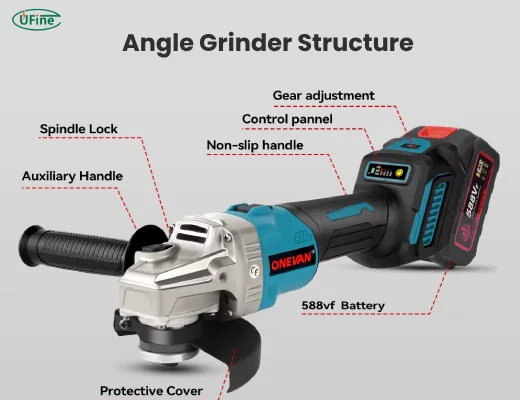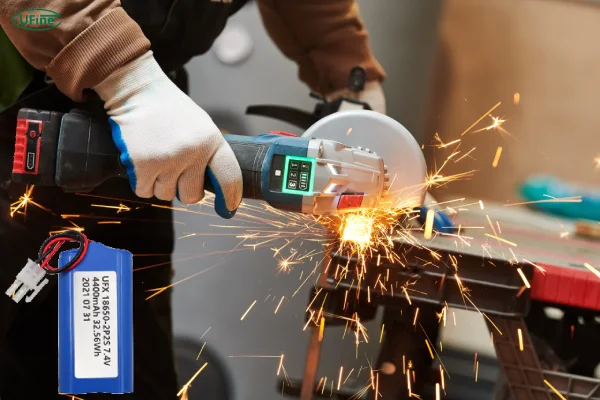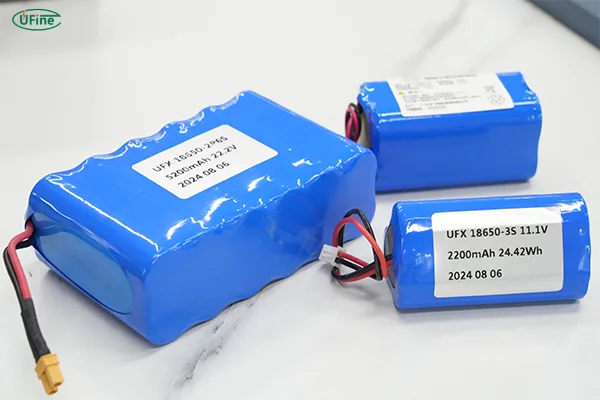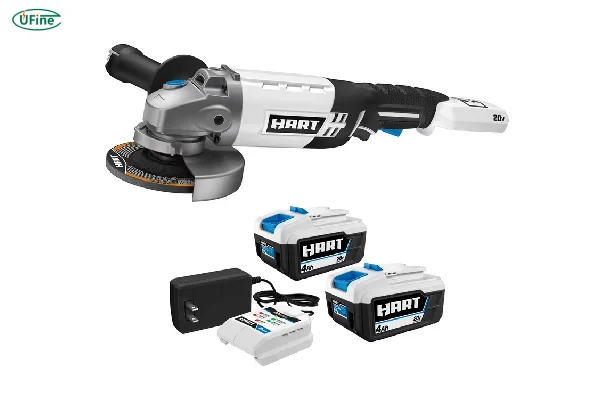
- Part 1. How does the battery affect the performance of the angle grinder?
- Part 2. Wireless and wired angle grinder: battery comparison
- Part 3. Angle grinder battery chemical types
- Part 4. Which battery lasts the longest?
- Part 5. How to extend the life of angle grinder battery?
- Part 6. Buy angle grinder battery: 7 keys
- Part 7. How to choose angle grinder battery charger?
- Part 8. Final thoughts
- Part 9. FAQs
Part 1. How does the battery affect the performance of the angle grinder?
The battery is the heart of your cordless angle grinder. Without the right battery, your tool can feel sluggish or stop mid-job. An angle grinder battery directly affects power, runtime, cutting speed, and even tool lifespan. If you’ve ever had an angle grinder suddenly shut down in the middle of a cut, chances are the battery was to blame.
A higher-quality battery delivers better torque, smoother operation, and consistent power. For professionals and DIY users alike, choosing the right angle grinder battery isn’t just a detail—it’s a decision that impacts your work every day.
Part 2. Wireless and wired angle grinder: battery comparison
Cordless angle grinders have become very popular. But how do they compare to traditional wired models? Let’s look at 7 key aspects:
- Mobility: Battery-powered grinders offer total freedom. No cords to trip over or plug into.
- Power Output: Wired models usually win on raw power. But with the right battery (like a high-rate lithium pack), modern cordless grinders come close.
- Runtime: A wired grinder never runs out. But with a high-capacity angle grinder battery, cordless models can handle long sessions too.
- Weight: Battery packs add weight. This can reduce comfort during long jobs.
- Maintenance: Corded models need less battery care. Battery tools need charging, monitoring, and sometimes replacement.
- Cost: Cordless grinders tend to be pricier upfront due to battery and charger costs.
- Safety: Cordless grinders are safer in wet or outdoor environments—no risk of electric shock from cords.
| Feature | Cordless (Battery) | Corded (Wired) |
|---|---|---|
| Portability | High | Low |
| Power Consistency | Depends on battery | Constant |
| Runtime | Limited by battery capacity | Unlimited |
| Convenience | No cords, very mobile | Needs socket |
| Maintenance | Battery care needed | Minimal |
| Weight | Heavier due to battery | Lighter |
| Price | Higher upfront | Generally cheaper |
Ultimately, your choice depends on what matters more: unlimited power or unmatched flexibility.
Part 3. Angle grinder battery chemical types
Let’s dive deeper. Not all angle grinder batteries are the same. They use different chemistries:
- Lithium-ion (Li-ion): The most common today. Lightweight, high energy density, and long cycle life. Great for pros and daily users.
- Lithium Iron Phosphate (LiFePO4): Safer and more stable, but slightly heavier. Perfect for jobs requiring extreme durability and thermal resistance.
- Nickel-Cadmium (NiCd): Older tech. Heavier, with memory effect issues. Rarely used in modern tools.
- Nickel-Metal Hydride (NiMH): Better than NiCd, but not as efficient as lithium-based types.
At Ufine Battery, we specialize in custom lithium battery solutions for power tools—including LiFePO4, lithium polymer, 18650 cells, and more. We design battery packs that fit your specific voltage, capacity, and size needs. If you’re a brand or supplier looking for custom battery solutions, Contact us now!
Lithium Ion Battery VS Nickel Cadmium Battery: Which Battery is Better?
Part 4. Which battery lasts the longest?
In terms of lifespan and runtime:
- LiFePO4 batteries offer the longest cycle life—often over 2,000 full charges.
- Li-ion batteries balance performance and size with up to 1,000 cycles.
- Lower-tech options like NiMH and NiCd degrade much faster.
But remember, real-world performance also depends on usage patterns, discharge depth, and storage conditions. A high-quality lithium battery, when used properly, will serve you faithfully for years.
Part 5. How to extend the life of angle grinder battery?
Want your angle grinder battery to last longer? Here are some essential tips:
- Don’t overcharge: Use a charger with automatic shut-off.
- Avoid full discharges: Recharge before the battery hits zero.
- Keep it cool: Store batteries away from extreme heat.
- Use the right charger: Mismatched chargers damage cells.
- Store at partial charge: Around 40-60% is ideal for long-term storage.
- Don’t leave it in the tool: Especially if the grinder is in a hot place like a van or garage.
With these simple habits, your battery will stay stronger, longer.
Part 6. Buy angle grinder battery: 7 keys
Before buying a replacement or upgrade, here’s what to look for:
- Voltage Compatibility: Match your tool’s required voltage (usually 18V or 20V).
- Capacity (Ah): Higher Ah = longer runtime.
- Discharge Rate (C rating): Determines how much power the battery can deliver quickly.
- Battery Chemistry: Choose between Li-ion, LiFePO4, etc.
- Form Factor: Make sure it fits your grinder’s battery slot.
- Cycle Life: Look for specs that guarantee at least 500–1,000 cycles.
- Brand Trust: Quality matters. Poor batteries can be unsafe.
At Ufine Battery, we can help you design or source the ideal angle grinder battery for your application—whether it’s high current, high safety, or ultra-thin format. Let us know your needs.
Part 7. How to choose angle grinder battery charger?
The charger matters just as much as the battery. Here’s how to pick a good one:
- Smart Charging: Look for chargers with overcharge and temperature protection.
- Fast Charging Support: Some high-capacity batteries benefit from rapid chargers.
- Voltage Match: Always match the charger voltage to your battery.
- Certifications: Look for CE, UL, or other safety marks.
- Brand Compatibility: Some brands only work with proprietary chargers.
A well-paired charger not only extends battery life—it keeps your work moving without delays.
Part 8. Final thoughts
Choosing the right angle grinder battery is more than a technical decision—it’s a decision that affects your work quality, safety, and efficiency. The type of battery, its chemistry, its charge method, and even how you store it—all of these factors come into play.
At Ufine Battery, we understand these needs. That’s why we offer custom lithium battery solutions for tools like angle grinders. Whether you need a compact pack for portability or a high-discharge pack for heavy-duty grinding, we’ve got you covered. Contact us today and let’s build a battery that works exactly the way you need it to.
Part 9. FAQs
Can I use any battery in my angle grinder?
No. Always match the voltage and connector type. Wrong batteries can damage the tool or pose safety risks.
Why does my battery run out so fast?
It may be low capacity, old, or not fully charged. Also, grinding heavy materials drains power quickly.
Are third-party batteries safe to use?
Only if they’re from a trusted manufacturer. Look for protections against overcharge, short circuit, and overheat.
How do I know when to replace my angle grinder battery?
If it charges slowly, drains fast, or overheats, it’s time to replace it.
Can I upgrade to a higher capacity battery?
Yes—if it matches your tool’s voltage and size. Just make sure your charger can handle it.
Related Tags:
More Articles

The Ultimate Guide to 24V Power Wheels Battery
Discover the best 24V Power Wheels battery for kids’ vehicles. Learn features, benefits, charging tips, and how to extend battery life for hours of fun.
Lithium Ion Battery VS Nickel Cadmium Battery: Which Battery is Better?
Compare Li-ion and NiCd batteries: energy density, lifespan, memory effect, cost, and best uses for devices, power tools, or industrial equipment.
Group 35 Battery Size, Type & Best Options for Your Car (2025 Guide)
Discover the complete group 35 battery guide with detailed size charts, battery types, pricing, applications, and recommended brands for your car in 2025.
Best Group 34 Battery Guide: AGM, Lithium & Lead-Acid Options
Discover Group 34 battery dimensions, capacity, CCA ratings, and the best AGM or lithium options. Learn which Group Size 34 battery fits your car.
Understanding 5V Batteries: From Basics to Choosing the Right Charger
Discover everything about 5V batteries, from types and capacities to applications and charging options. Learn how to make the best choice for your power needs.






